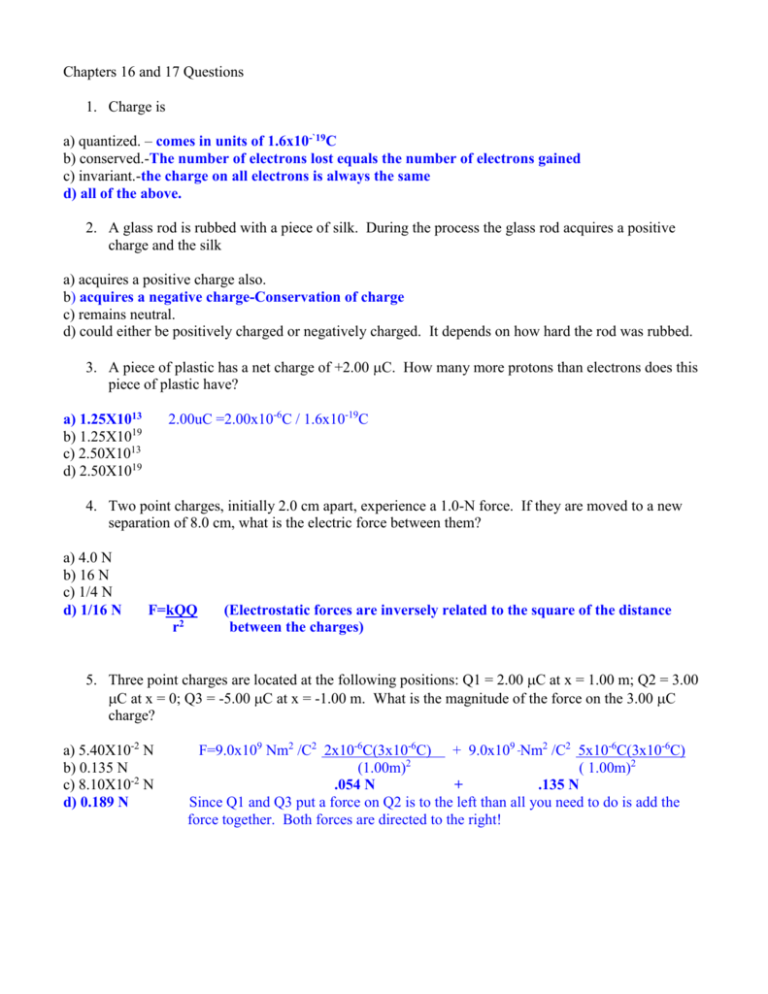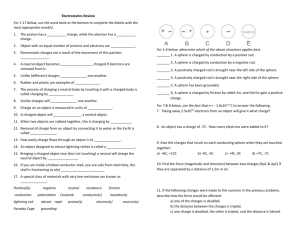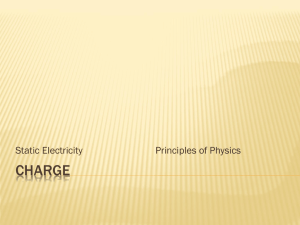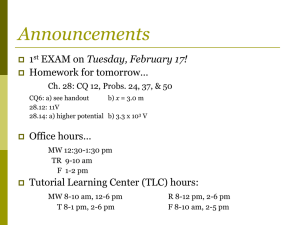Document
advertisement

Chapters 16 and 17 Questions 1. Charge is a) quantized. – comes in units of 1.6x10-`19C b) conserved.-The number of electrons lost equals the number of electrons gained c) invariant.-the charge on all electrons is always the same d) all of the above. 2. A glass rod is rubbed with a piece of silk. During the process the glass rod acquires a positive charge and the silk a) acquires a positive charge also. b) acquires a negative charge-Conservation of charge c) remains neutral. d) could either be positively charged or negatively charged. It depends on how hard the rod was rubbed. 3. A piece of plastic has a net charge of +2.00 C. How many more protons than electrons does this piece of plastic have? 2.00uC =2.00x10-6C / 1.6x10-19C a) 1.25X1013 b) 1.25X1019 c) 2.50X1013 d) 2.50X1019 4. Two point charges, initially 2.0 cm apart, experience a 1.0-N force. If they are moved to a new separation of 8.0 cm, what is the electric force between them? a) 4.0 N b) 16 N c) 1/4 N d) 1/16 N F=kQQ r2 (Electrostatic forces are inversely related to the square of the distance between the charges) 5. Three point charges are located at the following positions: Q1 = 2.00 C at x = 1.00 m; Q2 = 3.00 C at x = 0; Q3 = -5.00 C at x = -1.00 m. What is the magnitude of the force on the 3.00 C charge? a) 5.40X10-2 N b) 0.135 N c) 8.10X10-2 N d) 0.189 N F=9.0x109 Nm2 /C2 2x10-6C(3x10-6C) + 9.0x109 Nm2 /C2 5x10-6C(3x10-6C) (1.00m)2 ( 1.00m)2 .054 N + .135 N Since Q1 and Q3 put a force on Q2 is to the left than all you need to do is add the force together. Both forces are directed to the right! 6. A negatively charged rod is brought near one end of an uncharged metal bar. The end of the metal bar farthest from the charged rod will be charged a) positive b) negative the negatively charged rod will repel the electrons through the metal bar to the opposite end c) neutral d) none of the above 7. A point charge of +Q is placed at the centroid of an equilateral triangle. When a second charge of +Q is placed at one of the triangle's vertices, an electrostatic force of 4.0 N acts on it. What is the magnitude of the force that acts on the center charge when a third charge of +Q is placed at one of the other vertices? The x components of force generated by the two charges on a) zero Therefore Ry = (4N *sin 30) + (4N sin 30) = 2N up + 2N up b) 4.0 N . c) 8.0 N d) 16 N 8. Two charged objects attract each other with a force F. What happens to the force between them if one charge is doubled, the other charge is tripled, and the separation distance between their centers is reduced to one-fourth its original value? The force is now equal to a) 16F b) 24F c) (3/8)F d) 96F 3x2 = 96 (1/4)2 9. An originally neutral electroscope is briefly touched with a positively charged glass rod. The electroscope – We will go over charging on Monday a) remains neutral. b) becomes negatively charged. c) becomes positively charged. Charging by conduction creates the same sign charge d) could become either positively or negatively charged, depending on the time of contact. 10. Sphere A carries a net positive charge, and sphere B is neutral. They are placed near each other on an insulated table. Sphere B is briefly touched with a wire that is grounded. Which statement is correct? We will go over charging on Monday a) Sphere B remains neutral. b) Sphere B is now positively charged. c) Sphere B is now negatively charged-charging by induction creates an opposite charge d) The charge on sphere B cannot be determined without additional information. 11. Two 0.20-g metal speheres are hung from a common point by nonconducting threads which are 30 cm long. Both are given identical charges, and the electrostatic repulsion forces them apart until the angle between the threads is 20¯. How much charge was placed on each sphere? Vertical Tension=Gravity Horizontal Tension=Electrostatic o a) 10 nC Fg=Tcos10 (.30msin10)*2=r Tsin10o =kqq b) 15 nC Fg/cos10 = T r=.104m r2 c) 20 nC mg/cos10=T .00199N(sin10)=9.9e9q2 Distance d) 25 nC .00199 N=T (.104m)2 between spheres -8 Tension in string q=2x10 C or 20 nc 12. A styrofoam ball of mass 0.120 g is placed in an electric field of 6000 N/C pointing downward. What charge must be placed on the ball for it to be suspended? FE a) -16.0 nC FE=Fg E=F q=F q=mg b) -57.2 nC q E E Fg c) -125 nC d) -196 nC must be negative given that the field points downward = .000120kg(9.8m/s2) 6000N/C 13. A positive object touches a neutral electroscope, and the leaves separate. Then a negative object is brought near the electroscope, but does not touch it. What happens to the leaves? We will go over this on Monday a) They separate further. b) They move closer together. Postive and negatives attract. c) They are unaffected. d) Cannot be determined without further information. 14. Two 1.0 C charges have a force between them of 1.0 N. How far apart are they? a) 95 km b) 9.5 m c) 4.0 m d) 4.0 mm F = K qq r2 r = Kqq = F 9e9Nm2/C2 ( 1C)1C 1N =95000m 15. A solid block of metal is placed in a uniform electric field. Which statement is correct concerning the electric field in the block's interior? a) The interior field points in a direction opposite to the exterior field. b) The interior field points in a direction that is at right angles to the exterior field. c) The interior points in a direction that is parallel to the exterior field. d) There is no electric field in the block's interior. The electric field inside conductors is zero. 16. Which of the following is not a vector? a) electric force b) electric field c) electric charge d) electric line of force 17. A force of 6.0 N acts on a charge of 3.0 C when it is placed in a uniform electric field. What is the magnitude of this electric field? a) 18 MN/C b) 2.0 M N/C c) 0.50 MN/C d) 130 MN/C E=F Q 6.0N 3x10-6C E = 2,000,000 N/C or 2MN/ C 18. Can electric field lines intersect in free space? a) Yes, but only at the midpoint between two equal like charges. b) Yes, but only at the midpoint between a positive and a negative charge. c) Yes, but only at the centroid of an equilateral triangle with like charges at each corner. d) No. 19. A 5.0-C charge is 10 m from a small test charge of 1.0 nC. What is the electric field at the 1.0 nC charge? a) 4.5X106 N/C b) 4.5X107 N/C c) 4.5X108 N/C d) 4.5X109 N/C E=KQ = 9.0x109Nm2 (5.0C) r2 (10m)2 20. Two point charges each have a value of 3.0 C and are separated by a distance of 4.0 m. What is the electric field at a point midway between the two charges? a) zero b) 9.0X107 N/C c) 18X107 N/C d) 4.5X107 N/C The electric field is the algerbraic sum of the electric fields created by the point charges 21. Consider an equilateral triangle of side 20 cm. A charge of +2.0 C is placed at one vertex and charges of -4.0 C are placed at the other two vertices. Determine the magnitude and direction of the electric field at the center of the triangle. a) 2.7X106 N/C away from the +2.0 C b) 2.7X106 N/C toward the +2.0 C c) 3.3X106 away from the +2.0 C d) 3.3X106 N/C toward the +2.0 C E=KQ + KQ +KQ r2 r2 r2 22. Which of the following is an accurate statement? a) All parts of a perfect conductor are at the same potential. b) If a solid metal sphere carries a net charge, the charge will be uniformly distributed throughout the volume of the sphere. c) A conductor cannot carry a net charge. d) The electric field at the surface of a conductor is not necessarily perpendicular to the surface in all cases. 23. The net work done in moving an electron from point A, where the potential is -50 V, to point B, where the potential is +50 V, is a) +1.6X10-17 J b) -1.6X10-17 J W=qV W= 1.6x10-16J(+50V-(-50V)) c) zero The work will be done on the electron. It is going from d) none of the above. a position where it has high potential near a negative to a position where it has low potential near a positive The kinetic energy will increase and therefore the work is positive 24. Two identical aluminum objects are insulated from their surroundings. Object A has a net charge of excess electrons. Object B is grounded. Which object is at a higher potential? a) A b) B Potentials are in reference to positive test charge particles. Object A has a low potential because of its negative charge, while a grounded object will have zero potential that is therefore higher than the negative potential c) Both are at the same potential. d) Cannot be determined without more information. 25. The electron-volt is a unit of (Use your textbook to review this term) a) voltage. b) current. c) power. d) energy. Work =qV=1.6x10-19C (1 J ) = 1.6x10-19J that is called an eV. C 26. Consider a uniform electric field of 50 N/C directed toward the east. If the voltage measured relative to ground at a given point in the field is 80 V, what is the voltage at a point 1.0 m directly east of the point? a) 15 V b) 30 V c) 90 V d) 130 V E=V m dE=V 1.0m(50 N)= 1.0m ( 50 V ) = 50 V C m 80 V – 50 V = 30 V 27. How much work does 9.0 V do in moving 8.5X1018 electrons? a) 12 J b) 7.7 J c) 1.4 J d) 1.1 J W=qV W=8.5x1018(1.6x10-19C)(9.0V) 28. A proton moves 0.10 m along the direction of an electric field of magnitude 3.0 V/m. What is the change in kinetic energy of the proton? a) 4.8X10-20 J b) 3.2X10-20 J c) 1.6X10-20 J d) 8.0X10-21 J W=Fd W=qEd W=1.6x10-19C(3.0V)(.10m)=KE m 29. Two parallel plates, separated by 0.20 m, are connected to a 12-V battery. An electron released from rest at a location 0.10 m from the negative plate. When the electron arrives at a distance 0.050 m from the positive plate, what is the potential difference between the initial and final points? a) 2.4 V b) 3.0 V c) 4.8 V d) 6.0 V E=V d E =12V .20m E=60 V m V=Ed V=60V(.10m-.05m) = 3.0 V 30. A small charged ball is accelerated from rest to a speed v by a 500 V potential difference. If the potential difference is changed to 2000 V, what will the new speed of the ball be? a) v b) 2v W=qV=1/2 mv2 Since the potential difference is directly related to c) 4v square of the velocity. An increase of 4 in V will double the velocity d) 16v 31. A 4.0-g object carries a charge of 20 C. The object is accelerated from rest through a potential difference, and afterward the ball is moving at 2.0 m/s. What is the magnitude of the potential difference? a) 800 kV W=qV=1/2 mv2 =DKE V= 1/2 mv2 = ½ (.004kg) (2.0m/s)2 b) 400 kV q 2.0x10-5C c) 800 V d) 400 V 32. Several electrons are placed on a hollow conducting sphere. They a) clump together on the sphere's outer surface. b) clump together on the sphere's inner surface. c) become uniformly distributed on the sphere's outer surface-They get as far away from each other as possible d) become uniformly distributed on the sphere's inner surface. 33. Consider a uniform electric field of 50 N/C directed toward the east. If the voltage measured relative to ground at a given point is 80 V, what is the voltage at a point 1.0 m directly west of that point? 50 N/C a) 30 V V=ED b) 50 V V=50 V (1.0m) c) 80 V V =50 V d) 130 V 80V-50V=30 V ? 1.0 m 80 V 34. A 5.0-nC charge is at (0, 0) and a -2.0 nC charge is at (3.0 m, 0). If the potential is taken to be zero at infinity, what is the electric potential at point (0, 4.0 m)? a) 15 V V = kQ 9x109 N m2 (5.0 x10-9 C ) = V = kQ 9x109 N m2 (2.0 x10-9 C ) = b) 3.6 V r 4.0 m r 5.0 m c) 11 V V= 11.25 V= 3.6 V d) 19 V 35. The absolute potential at a distance of 2.0 m from a positive point charge is 100 V. What is the absolute potential 4.0 m away from the same point charge? a) 25 V V = KQ Since the absolute potential is inversely related to r then, doubling the b) 50 V r distance should reduce the potential by one-half. c) 200 V d) 400 V 36. What is the potential at a distance of 5.0X10-10 m from a nucleus of charge +60e? a) 140 V b) 170 V c) 210 V d) 250 V V=KQ r V=9.0x109 N m2 (60) 1.6x10-19 C 5.0x10-10 m






